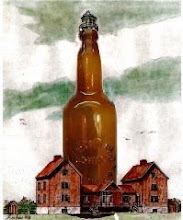Spring is here and time to start hopping-up the beers. The following is a good article from mr. malty.com describing how to get the most out of your hops.
Have you recently come across a craft brew with a massive hop flavor and a smooth bitterness that you really loved? If you're like me, you wondered how the brewery created such an incredibly huge, but smooth hop character. The secret, it turns out, is very large additions of late hops.
Late hopping is the addition of hops during the latter part of the boil. It is an excellent method for creating hop aroma and flavor in your beer. In general, any additions with less than 30 minutes left in the boil and prior to cooling the wort are considered late hop additions. Although some hop oils are lost during this shorter boil, reactions between the hop compounds and the wort create other desirable flavor-active compounds not found in hops.
Many brewers turn to dry hopping in an effort to get more hop flavor and aroma, but dry hopping results in a completely different hop character, which maybe out of place in certain styles.
While dry hopping is a great technique, it is often characterized as more resiny and grassy, while boiled hops are often characterized as more floral and spicy. Ray Daniels, in Designing Great Beers, says, "Late-hopped additions have been characterized as more floral, fragrant, and less grassy than dry-hopped additions."
Calculating the Numbers To use this technique in your own beers, replace all or part of your traditional bittering hop additions with additions at 20 minutes or less left in the boil, increasing the amount of hops to get the same IBUs. Replace all of your bittering hops for an intense hop flavor. Replace a lesser amount to just enhance the hop flavor.
Hop Selection
Select your late hop varieties based on how pleasing the aroma. Select hops for late hopping based on their aromatic quality. Utilize a number of low alpha aroma varieties as well as mid-alpha dual purpose hops for late hopping. Some examples are Styrian Golding, East Kent Golding, Cascade, Centennial, Crystal, Mount Hood, and US Fuggle.
Look for aromatic hop varieties with good flavor characteristics and low cohumulone values. In our experience, these are the hops that isomerize without imparting harsh or astringent-like hop profiles. This goes beyond late-hopping for flavor and aroma, and applies equally to smooth bittering early in the boil as well. The hops that have worked best for our late-hopping include Cascade, Amarillo, Tomahawk, Simcoe, Chinook, and a newer variety, Palisades. Tomahawk and Simcoe have relatively high alpha acid values and somewhat low cohumulone values and are best used in lesser percentages than the other hops mentioned. For English-style Ales, use East Kent Golding and Styrian Golding.
Some studies suggest that late hopping with high cohumulone hops tends to result in a more harsh bitterness. However, don't buy into the cohumulone equals 'harsh bitterness' theory. I also believe that the cohumulone argument is independent of how you are utilizing the hops-kettle hopping or late hopping. Some of the best smelling hops in the world are high in cohumulone and I plan to continue using them.
Given that a number of brewers report a less harsh bitter from late hopping, it might be a lesser issue than first thought. It might be more important to select late hops based on their flavors and aromas first, and their cohumulone fraction second.
With this technique comes the question of using whole leaf or pellet hops. Some use a false bottom in the boil kettle and are able to use whole hops for experiments. The concern was that a large amount of pellet hops might clog his counter-flow chiller. However, using whole hops results in a very large mass that can make it difficult to extract the wort at the end of the boil.
The majority of brewers I spoke with use pellet hops for this technique. Pellets break up quickly and expose the alpha acids for isomerization. Most select pellets for late/whirlpool hopping.
While isomerization is limited during a short boil, hop utilization isn't linear across the boil time. You don't need 6 times as much hops for a 10 minute boil as compared to a 60 minute boil. Assuming you're getting about 30% utilization at 60 minutes, you'll get around 17% at 20 minutes, 14% at 15 minutes, and around 10% at 10 minutes. So you'll need to approximately double or triple your hops to get an equivalent bitterness. If you're already calculating your bitterness with software or some other tool, use the same method to make this adjustment.
It is said that most formulas for calculating bitterness are not as reliable for very late hop additions, but don't let that stop you. It is quite difficult to detect a 5 IBU difference in most moderately bittered beers and impossible in a highly bittered beer.
In beers with significant bitterness (50+ IBU), you might still want to add a charge of high alpha hops early in the boil. If you don't, the amount of hop flavor can completely overwhelm some beers. late_hopping
Thursday, April 5, 2012
Subscribe to:
Post Comments (Atom)



No comments:
Post a Comment